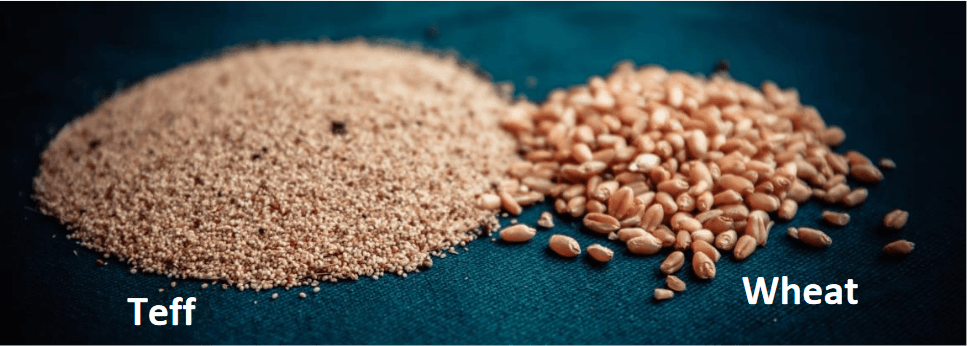
We are what we eat. Human health is facing challenges from lifestyle diseases such as diabetes and obesity. A sedentary lifestyle coupled with a lack of physical activity together with unhealthy diet habits (e.g., intake of sugary/energy drinks, extra salt, and sugar) is becoming a big threat to leading a healthy life. In ancient times, people mostly consumed fiber-oriented diets such as whole grains and cereals, and lifestyle diseases plaguing today’s society were absent.
Advancements in science and technology have moved our world to a better place to live in while putting the health of mankind at risk. Grain and cereal refinement to remove the bran and the germ is standard procedure for flour companies. Nonetheless, the bran which has been thrown out is recently being recommended as nutritional therapy for many metabolic disorders.
Recently, one of the world’s smallest ancient grains, teff, has gotten attention for its rich fiber content and high levels of nutrients. It is also gluten-free, which makes it the best option of grain for those with a gluten allergy (celiac disease). East African farmers from Ethiopia have been enjoying the benefits of teff for centuries. Ethiopians are known for their brand of cuisine known as “injera,” which is made out of teff. Where there is injera (a risen flatbread), there are Ethiopians. Teff is rich in minerals and fiber content; however, there is no scientific evidence for the health benefits of teff. Therefore, we aimed to unravel the role of teff for glucose metabolism using an animal model.
Since wheat is the most commonly consumed grain globally, we fed mice with either 30% wheat or 30% teff containing regular rodent chaw for 14 weeks. We, surprisingly, observed a reduction in the body weight of teff-eating mice in the first 3 weeks. This finding motivated us to further investigate the metabolic changes involved. Then, we started measuring glucose and insulin levels and metabolic hormones such as GLP-1 in both groups. After 14 weeks of this feeding period, the teff group reduced its body weight by 13% without a change in food intake. We also challenged mice with a high fathigh fat diet mixed with 30% of either teff or wheat flour. Unfortunately, we didn’t observe any difference in glucose metabolism with diet groups. In a regular diet, the teff-fed mice attained better glucose tolerance during an intraperitoneal glucose challenge. This result was sustained in both oral glucose and oral meal tolerance tests. Furthermore, insulin tolerance was also better in teff-fed mice. Then, we asked ourselves, “How could teff improve glucose homeostasis?”
To answer this question, we considered the special features of teff — its fiber content. It has been reported by several researchers that resistant starch, indigestible fiber, metabolized by microbiota colonization during digestion produces short-chain fatty acids as a byproduct. Therefore, we measured the concentration of the major short-chain fatty acids, including acetate, propionate, and butyrate in the caecum. We found that SCFA production, acetate by large, was higher in the teff group. It is also well documented that SCFAs can improve metabolism by modulating inflammatory responses in the body. Adding 30% teff to the mice diet abolished adipose tissue inflammation, which plays an important role in reducing insulin resistance. Furthermore, we also observed a substantial amount of newly discovered beige adipocyte formation with an increase in thermogenic marker gene Ucp1. This result was further supported by higher body temperatures measured from the rectus, indicating an increase in energy expenditure in teff-fed mice.
Next, we asked which part of results played the main role for glucose homeostasis: weight reduction, or adipocyte inflammation, or beige adipocyte formation? To answer this, we conducted a pair feeding body weight matched study by adjusting food with gavage for both teff and wheat groups in order to maintain similar body weight for 6 weeks. Surprisingly, we observed better glucose tolerance in the teff group without a change in body weight. Besides, the beige adipocyte marker Ucp1 was also increased in the teff group. However, there was no difference in adipose inflammation markers.
From this, we conclude that the glucose homeostasis maintained by teff groups was mainly due to beige adipocyte formation which might be initiated by SCFA through microbiota. We believe that adding teff to our menu might enhance our metabolic output by improving glucose homeostasis and weight management.
These findings are described in the article entitled Improved glucose metabolism by Eragrostis tef potentially through beige adipocyte formation and attenuating adipose tissue inflammation, recently published in the journal PLOS One.
Citation:
- Lemecha M, Morino K, Seifu D, Imamura T, Nakagawa F, Nagata A, et al. Improved glucose metabolism by Eragrostis tef potentially through beige adipocyte formation and attenuating adipose tissue inflammation. PLoS One. 2018;13:e0201661.









